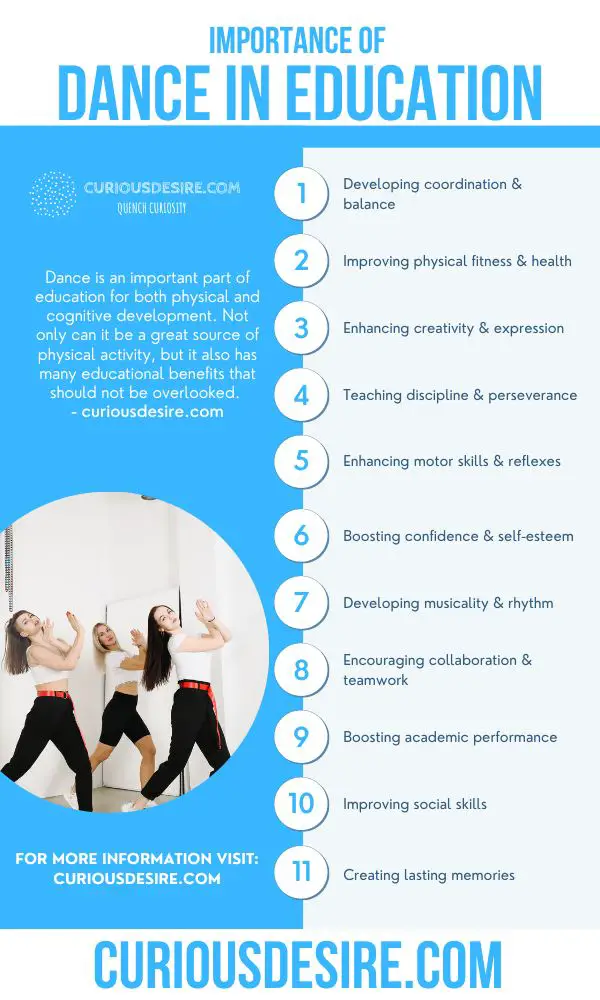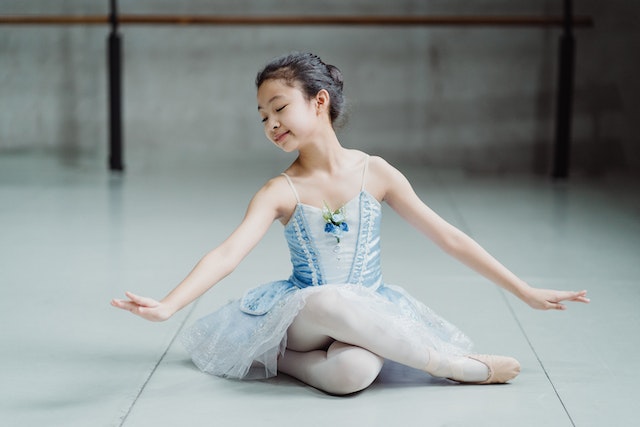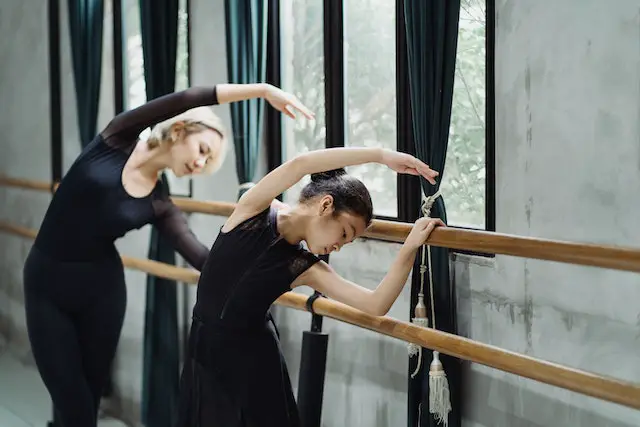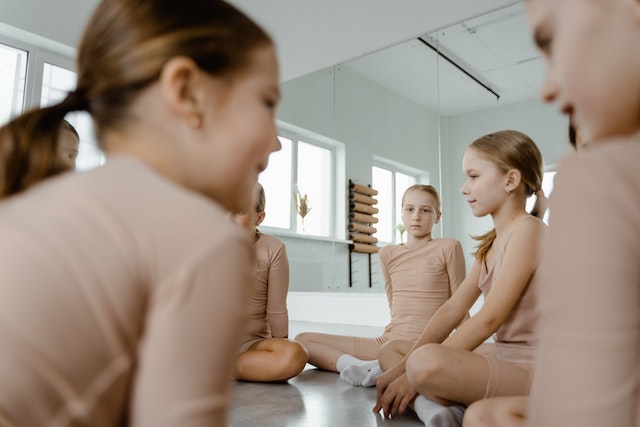Dance is an important part of education for both physical and cognitive development. Not only can it be a great source of physical activity, but it also has many educational benefits that should not be overlooked.
From developing coordination and problem-solving skills to providing an outlet for creative expression, it can help students learn in a variety of ways. In this article, we’ll take a look importance of dance in education.
15 Benefits of Dance in Education
Dance is a popular activity for children and teens and can have a number of benefits that carry over into academics. Here are 15 reasons for the importance of dance in education:
1. Developing coordination & balance
Dance requires a lot of physical movement that helps students to develop better coordination and balance as they learn the steps of different dances. This can also help them in other physical activities like sports, martial arts, and more.
It can also be beneficial in terms of cognitive development as it requires students to pay attention, remember the steps and think on their feet.

2. Improving physical fitness & health
Dance can help improve physical fitness and overall health by providing an enjoyable form of exercise. It also allows kids to express themselves creatively while getting their heart rates up. This can help to improve concentration and reduce stress levels.
Through dance, students can learn about taking care of their bodies and how exercise helps them feel better both physically and emotionally.
3. Enhancing creativity & expression
Dance is a great way for kids to express themselves through movement. It allows them to use their imaginations to create something new or explore existing ideas in the form of movement. This can help to enhance their creative problem-solving skills.
It can also foster a sense of community among students as they collaborate on dances and perform them together.
4. Teaching discipline & perseverance
Dance requires dedication and hard work in order to learn the steps and choreography. This teaches kids how to persevere and stay disciplined even when things get tough. It also encourages them to set goals and strive for excellence in their performance.
However, it’s important to provide positive reinforcement rather than punishment, as this can help keep kids motivated and engaged.

5. Enhancing motor skills & reflexes
As students learn dance steps, they are also improving their motor skills and reflexes. This is beneficial for both physical education classes and academics as it helps them become more coordinated in other activities.
This can also help to improve coordination in other areas, such as sports and martial arts. In addition, the increased flexibility from dance can lead to better posture, which is important for academic success.
6. Boosting confidence & self-esteem
Dance can be a great source of confidence-building as it provides an outlet for self-expression. As students learn the steps and perform in front of others, they can gain a sense of accomplishment which can boost their self-esteem. This is especially beneficial for those who may not excel in other areas, such as academics or sports.
It’s also important to foster an environment that encourages positivity and respect rather than competition and judgment. This can help to create a safe space for all students to express themselves through dance.
7. Developing musicality & rhythm
Dance is an excellent way for kids to explore music and develop their musicality. Through dance, they can learn about different rhythms, tempos, and time signatures which are important in music.
This can help them in other areas of music, such as playing instruments, singing, and understanding basic music theory.
It also allows them to explore different styles of music which gives them a better appreciation for the medium and an increased awareness of the cultural influences behind it.
8. Encouraging collaboration & teamwork
Collaboration and teamwork are key components of dance. As students work together to create and learn the choreography, they can learn about working with others in order to achieve a common goal. This is important for success both on and off the stage.
It also provides an opportunity for them to practice communication skills such as expressing ideas clearly, listening actively, and providing constructive feedback. These are valuable skills that can benefit them in other parts of their lives.
9. Boosting academic performance
Studies have shown that physical activity, such as dance, can have a positive effect on academic performance. Dance provides an outlet for creative expression, which is important for learning, and it increases coordination, motor skills, and reflexes which are beneficial in other areas of academics.
It also encourages discipline and perseverance, which are essential qualities for academic success. Furthermore, the confidence and self-esteem that come with mastering a dance routine can boost motivation and help kids stay focused in the classroom.

10. Improving social skills
Dancing also provides an opportunity for students to interact with each other in a healthy and positive way. Through choreography and improvisation, they can practice social skills such as cooperation, negotiation, problem-solving, and compromise.
This can help them to develop relationships with their peers and build a sense of community within the class. In addition, it can be used as a tool for teaching respect and understanding for others, even when they may have different opinions or perspectives.
11. Creating lasting memories
Dancing is a fun and meaningful activity that can create lasting memories for students. As they practice, perform, and share this experience with each other, they can build relationships and create positive memories that will stay with them long after the dancing stops.
These memories can be used to help motivate and inspire them throughout their lives, and they can look back on these moments fondly as they grow older.
12. Encouraging physical activity
Dance is a great way to get kids moving and encourage physical activity. This can help to combat the inactivity that is often associated with the digital age and promote a more active lifestyle overall.
By teaching students how to move their bodies in various ways, they will be able to stay fit while having fun, and they will develop an appreciation and knowledge of a physical activity that can help them maintain their health in the future.

13. Expressing creativity
Dance is a powerful form of expression that can help students to express their creativity. They can explore various forms and styles of movement, allowing them to create something unique and meaningful.
Through this process, they will learn about themselves and gain a better understanding of the world around them. This can open up new opportunities for self-expression and help them to develop their own individual style.
14. Developing focus and discipline
Dancing also helps to develop focus and discipline, which are important qualities for success in any area of life. By learning how to master a routine, students will learn the importance of practice and hard work and will be able to apply this knowledge to other areas of their lives.
Furthermore, they will gain a better understanding of the importance of perseverance, which is essential if they want to reach their goals.
15. Having Fun
Ultimately, dancing is a great way for students to have fun and enjoy themselves. It can help to break up the monotony of everyday life and provide an outlet for them to explore their creativity and imagination.
By allowing students to express themselves freely in a non-competitive environment, they can learn about the joys of movement and develop a lifelong appreciation for dance.
Ultimately, dance can be a great way to help students unleash their creative potential while also developing important life skills such as focus, discipline, and coordination. By incorporating dance into the classroom, teachers can foster an environment where students can grow and thrive.
Conclusion
In conclusion, dance can be a powerful tool for teaching students important life skills while also providing them with a meaningful and enjoyable experience. It can help to foster creativity, boost self-confidence, improve social skills, create lasting memories, encourage physical activity, and develop focus and discipline.
By incorporating dance into the classroom, teachers can provide their students with the opportunity to explore their unique potential and gain valuable skills that will help them throughout their lives.